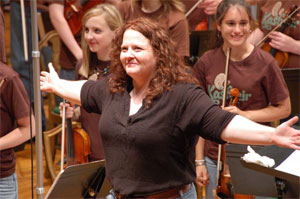by Daniel Hathaway

CYO and its dynamic conductor raised the curtain with John Adams’s high-energy overture, Short Ride in a Fast Machine. Driven by the pervasive rhythm of a wood block and propelled by an excellent brass section, the piece raced along like the top-performance sports car it invokes and safely arrived at its destination (and with no white knuckles on the curves!)
Trautwein’s well-trained string players from El Sistema @ University Circle took inside chairs next to their older counterparts for Brian Balmages’s Burst, a didactic piece written to challenge first-year string students — but pretty easy stuff for CYO members. Having heard El Sistema’s first read-through of the piece in the fall, it was fun to note how far they had come by early December — something you could judge easily by their confidence and onstage demeanor.
The rest of the short first half of the concert belonged to flutist Peter Feher, 16, a high school junior, who masterfully handled the solo part in Swiss composer Frank Martin’s Ballade for Flute and Orchestra. Feher was up against the entire string section, which in most professional situations would be reduced for the occasion, but he managed to project nicely even when Martin sent him into the nether regions of the instrument.
The Oblivion Project, with cellist and leader Derek Snyder, violinist Ken Johnston, pianist Mau Quiros, guitarist Erin Vaughn, bassist Gerald Torres and percussionist Patrick Graney, took their places front and center after intermission. Founded to play the music of Astor Piazzolla, the group performed Piazzolla’s music on this occasion in arrangements for ensemble and full orchestra by Snyder and Quiros. Ironically, on Saturday the group lacked the sound of the bandonéon (usually played by Julien Labro), the composer’s own instrument and normally an important ingredient in the sound of Argentine tango.
The Oblivion Project’s playlist included Buenos Aires Hora Cero, Escualo, Los Pararos Perdidas, Milonga Sin Parabras, Balada para un loco and Concierto para Quinteto. Though excellent players all, the Oblivion musicians didn’t get completely under the skin of the genre. Tempos tended toward the slow side and solos needed more passion and panache. The sound system wasn’t helpful — it isolated the Project players from the orchestra and distorted their tone. The invited singer, Migguel Anggelo, also an actor and dancer, performed in a histrionic style more redolent of Las Vegas than Buenos Aires.
Last up was Stravinsky’s 1919 Firebird Suite, which received a fearless and quite creditable reading from Grossman and the orchestra. Soloists played with confidence (especially the bassoonist in the Berceuse) and some mishaps (water in the oboist’s reed) were righted nicely the second time around.
It’s inspiring to see so many young musicians enjoying themselves onstage. Even so, the CYO organizers could do them and the audience a favor by tightening up their shows. Lots of commentary from the stage involving the tedious passing of a microphone (they still come with cords at CSU!), an Oblivion Project encore, a 25-minute intermission and a second, unscheduled intermission to reset the stage for Firebird stretched the evening to two hours and forty minutes — well beyond the point when even the most devoted of followers begin to get fidgety.
Published on ClevelandClassical.com December 17, 2013
Click here for a printable version of this article.



